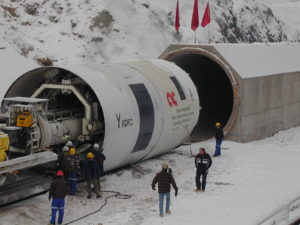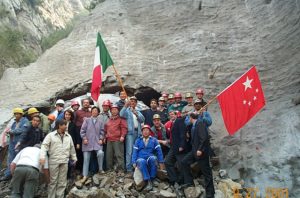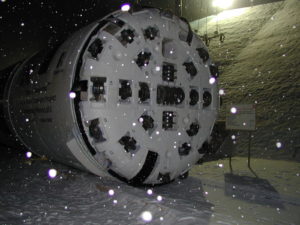![65 Years of Innovation and Experience [default]](https://www.robbinstbm.com/wp-content/uploads/2017/04/Side-Bar-Blue-Blocks_70-Years.jpg)
A Solution for Every Condition: Search our Project Database
Project Map
FEATURED PRODUCT: CROSSOVER MACHINES
Our History
A Legacy of Innovation
Information 24/7
News & Media
Insights in the Industry:
Read the Robbins Blog

The Yellow River Water Diversion Project is an ambitious network of tunnels that brings water to chronically dry areas of Shanxi Province. The water system consists of multiple tunnels totaling over 100 km (62 mi) in length.
The Joint Venture (CMC, Impregilo, Chinese Water Conservancy and Hydropower Engineering Bureau No. 4) was awarded Lots 2 and 3 in 1997. Cooperativa Muratori Cementisti Ravenna (CMC) of Italy was awarded the contract for Lot 5 in 2000. All of the contractors chose Robbins Double Shield TBMs to bore through the challenging geology.
Lot 2: The geology in Lot 2 consisted of limestone and dolomitic rock characterized by occasional faults. Karst formations were also abundant. The Unconfined Compressive Strength (UCS) of the rock was 39 – 137 MPa (6 – 20 ksi).
Lot 3: Lot 3 geology was made up of dipping and folded dolomitic limestone and Triassic sandstone and mudstone with a UCS the same as that of Lot 2. The rock is dominated by abundant high-angled faults with occasional karst formations.
Lot 5: Lot 5 consisted of limestone, sandstone, and siltstone with occasional faults and an UCS of 25 – 206 Mpa (4 – 30 ksi).
Lot 2: Lot 2 used two Robbins Double Shield TBMs. The first machine was a new Robbins TBM that excavated two tunnels (Tunnels T4 and T5) of 6.6 km (4.1 mi) and 25.5 km (15.8 mi) in length. The TBM featured a 4.92 m (16.1 ft) diameter cutterhead and 17 inch (432 mm) cutters. The TBM was equipped with a variable frequency drive (VFD) and supplied 1,575 kW (2,112 hp) to the cutterhead. The machine could generate a cutterhead thrust of 9,074 kN (2,040,000 lb) and create a torque of 2,159,424 N-m (1,591,300 lb-ft).
For the second machine on Lot 2, Robbins also refurbished a 4.9 m diameter (16.1 ft) TBM for a 14 km (8.7 mi) long tunnel (Tunnel T6). This TBM featured 17 inch (432 mm) cutters with six 75/210 kW motors and a total installed power of 3,000 kW.
Both TBMs used identical back-up systems. Each 300 m (984 ft) long back-up system used a mucking-out train with ballasted muck cars and a pair of rail sidings to form an onboard California switch. Water services, the ventilation cassette and cable reels were near the rear of the back-up.
 Lot 3: Another Double Shield TBM was used for a 22 km (13.7 mi) long section of tunnel T7 in Lot 3. The 4.8 m (15.7 ft) diameter Robbins Double Shield TBM featured 17 inch (432 mm) cutters and could generate a cutterhead thrust of 9,074 kN (2,040,000lb). The machine could also generate a torque of 2,159,424 N-m (1,591,300 lb-ft). A TBM made by NFM bored the other half of the 40.7 km long T7 tunnel.
Lot 3: Another Double Shield TBM was used for a 22 km (13.7 mi) long section of tunnel T7 in Lot 3. The 4.8 m (15.7 ft) diameter Robbins Double Shield TBM featured 17 inch (432 mm) cutters and could generate a cutterhead thrust of 9,074 kN (2,040,000lb). The machine could also generate a torque of 2,159,424 N-m (1,591,300 lb-ft). A TBM made by NFM bored the other half of the 40.7 km long T7 tunnel.
The back-up system for this TBM was identical to those in Lot 2.
Lot 5: For Lot 5, CMC utilized a 4.8 m (15.7 ft) diameter Robbins TBM that had been stored in China since 1994. The machine was completely refurbished by Robbins for the project. CMC and Robbins agreed to reinforce the existing cutterhead for improved reliability in fractured geology. The machine was also fitted with a tail shield and wire brush seals to protect against water inflows. The machine featured 17 inch (432 mm) cutters and it could generate a cutterhead thrust of 7,562 kN (1,700,013 lb). The torque at the cutterhead reached up to 1,936,568 N-m (1,438,000 lb-ft).
The back-up system for the Lot 5 TBM was custom built for increased performance. Robbins extended the back-up to provide for a train length on deck with sufficient muck carrying and materials delivery capacity for two TBM strokes. The segment handling system was modified as well for more rapid handling of tunnel lining segments.
Excavation began simultaneously on Lots 2 and 3 in February 1999. The T4 TBM bored the 6.6 km (4.1 mi) tunnel in just eight months and experienced relatively few problems. The machine broke a world record in its size class with a best month of 1,822 m (5,978 ft) and achieved a best day of 99.4 m (326 ft). The same TBM bored the 25.5 km (15.8 mi) long T5 tunnel beginning in November 1999 and ending in 2001 with few problems.
The refurbished Robbins TBM started boring the 14 km (8.7 mi) long T6 tunnel in December 1999. The TBM encountered long sections of clay and a 6 m (19.7 ft) wide karst cavity that had to be filled with pea gravel and reinforced concrete to let the machine pass. Despite the challenges, the TBM achieved advance rates of 81.0 m (266 ft), a best month of 1,375 m (4,511 ft), and an average monthly advance rate of 550 m (1,804 ft).

Boring the 22 km (13.7 mi) section of Tunnel T7 at Lot 3 began in February 1999 and ended in April 2001. The Robbins TBM and the NFM machine began at opposite ends of the tunnel and met in the middle. The Robbins machine encountered a 50/50 limestone/sandstone mixture of abrasive rock and several high-angled fault lines. However, it still managed to achieve an average month of over 700 m (2,297 ft) and had a best month of 1,281 m (4,203 ft).
Lot 5 excavation began as boring at Lots 2 and 3 was finishing up in September 2000. By December 8th, the refurbished Robbins TBM had already set a best day of 36.1 m (118 ft) and averaged over 1,000 m (3,281 ft) in its first month. The machine later set a world record for its size class at 1,352 m (4,436 ft) per month. The TBM holed through the 13.5 km (8.4 mi) long tunnel in September 2001.

 Close
Close